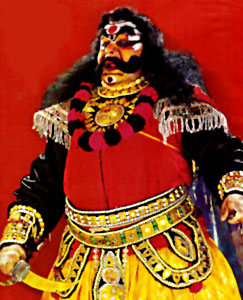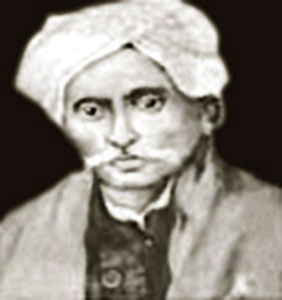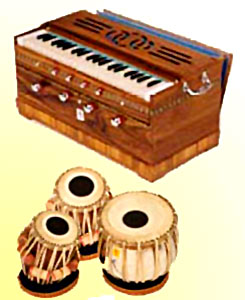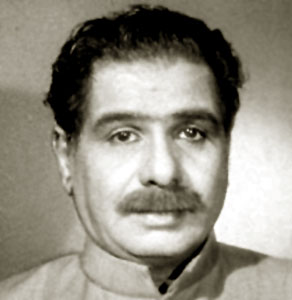 Evidence from sculpture and inscriptions indicates that theatrical activities flourished in the present south-eastern state of Andhra Pradesh as early as the second century BC. The Nagarjunakonda excavations laid bare an amphitheatre dated by researchers to the second or third century AD. However, the first definite word of theatre in the Telugu language appears in Palkuriki Somanatha`s poetical texts, Basavapuranamu and Panditaradhya charitramu. He mentions a play, Siriyalu charitra or `Siriyalu`s Story`. This presented with appropriate prelude, correct speech and diction, and proper action during the Sivaratri festival at Srisailam. The only surviving medieval script is Kridabhiramamu or `Graceful Sport` by Vinukonda Vallabharayudu. This was written in the fourteenth century and belongs to the genre of vithi, one of the ten rupakas.
Evidence from sculpture and inscriptions indicates that theatrical activities flourished in the present south-eastern state of Andhra Pradesh as early as the second century BC. The Nagarjunakonda excavations laid bare an amphitheatre dated by researchers to the second or third century AD. However, the first definite word of theatre in the Telugu language appears in Palkuriki Somanatha`s poetical texts, Basavapuranamu and Panditaradhya charitramu. He mentions a play, Siriyalu charitra or `Siriyalu`s Story`. This presented with appropriate prelude, correct speech and diction, and proper action during the Sivaratri festival at Srisailam. The only surviving medieval script is Kridabhiramamu or `Graceful Sport` by Vinukonda Vallabharayudu. This was written in the fourteenth century and belongs to the genre of vithi, one of the ten rupakas.
In later days Sanskrit plays were translated in poetic or kavya, but not in dramatic form. However, folk theatre entertained the rural public. During the reign of the Nayaka and Maratha kings based in Thanjavur, Tamil Nadu, Telugu received a boost as their court language. Thus Yakshaganam, which is also called as Vithi Natakam or Bhagavatam, reached its artistic zenith. Tolu Bommalata shadow puppetry, Kuchipudi and Kalapam Voggukatha narrative troupes, Pagati-veshalu, Kuravani dance-drama, Harikatha solo narratives, etc. all these folk forms remained popular for over eight centuries. After the introduction of English education in the nineteenth century, Telugu drama emerged as a distinct literary genre.
It is commonly believed that the first modern Telugu play was Korada Ramachandra Sastry`s Manjari-Madhukariyam i.e. `Tale of Manjari and Madhukara` in 1860. This was a short work with a romantic plot and Sanskritized diction. But no authentic proof exists to validate this claim. The first play may have been Varanasi Dharma Suri`s Narakasura vijaya vyayogamu i.e. `Narakasura`s Victory` in 1871 in the vyayoga genre. This was translated into Telugu by Kokkonda Venkataratnam Pantulu.
In the following year partial translations of Kalidasa`s Abhijnana-Sakuntala by both Paravastu Rangacharyulu and Kandukuri Veeresalingam was done. Translations from English soon followed. There were many in the list. The first among them was Vavilala Vasudeva Sastrys Sizaru charitramu i.e. `Caesar`s Story` in 1875. Sastry was a trendsetter. He also wrote the first original Telugu social drama, Nandaka rajyamu i.e. `Nandaka`s Kingdom` in 1880. This was a biting satire on feuds between two Brahman sects. These pioneers ushered in the three distinct dramatic directions which continued for the next half-century. Translations from Sanskrit, translations from English, and original works which combined both traditions were all included.
Between 1860 and 1880, drama was considered only as texts for reading. Veeresalingam initiated proscenium theatre by staging his Vyavahara dharmabodhini in 1880 with his students and friends as actors. In that year, a travelling company, Tantipurastha Nataka Samajam, popularly called Dharwada Nataka Samajam, toured Andhra`s northern coastal towns presenting a series of plays in Hindi. Its well-performed productions created a sensation and, as a result, several writers and actors there took to theatre seriously. Kondubhotla Subramanya Sastry in Guntur, Nadella Purushothama Kavi in Machilipatnam, and Vaddadi Subbarayudu in Rajahmundry were worth mentionable.
Kondubhotla founded Hindu Nataka Samajam in 1881, which staged thirty of his plays not only in Guntur, but in neighbouring towns as well. Nadella`s National Theatrical Society with Eemani Laxmana Swamy as the main actor, produced drama in Hindi, following the Dharwada Company`s practice. Vaddadi not only translated Bhatta Narayana`s Venisamhara from Sanskrit but also acted in it creditably as Aswatthama. Other troupes like Jaganmitra Samajam of Visakhapatnam in 1882 and Hindu Nataka Samajam of Kakinada in 1884 soon followed suit.
In 1887, the emergence of padya natakam i.e. verse drama achieved a landmark. Inspired by the musical productions of Parsi theatre companies, Dharmavaram Ramakrishnamacharyulu started this trend in Bellary in Karnataka with Chitra Naliyam. This kind of stage music became immediately popular not only in Bellary, but all over Andhra. Through padya natakam, actor-singers turned stars overnight. To meet the audiences overwhelming response, several amateur groups performed musical theatre. New authors, basically poets, began writing plays that contained good poetry, though not necessarily good drama. Dharmavaram`s contemporary and professional rival from Bellary was Kolachalam Srinivasa Rao. He was better known for his historical plays, among which Ramaraju charitramu or Fall of Vijayanagar in 1907 is considered a masterpiece. He founded the Sumanorama Sabha, a theatre association that became famous owing to its lead actor, Bellary Raghava. Rao was perhaps the first Indian theatre historian to write a book in English on world drama i.e. `A History of World Drama` in 1907.
 Two other significant contributions to dramatic literature make this era noteworthy. They were Kanyasulkam i.e. `Bride Price` in 1892 by Gurazada Appa Rao. This was a full-length comedy dealing with contemporary evils such as selling brides and prohibiting widows from remarrying. Prataparudriya natakam i.e. `Prataparudra`s Play` in 1897 by the literary commentator and translator Vedam Venkataraya Sastry is still popular because it created memorable semi-historical characters and dramatized incidents from Telugu history, though often imaginary.
Two other significant contributions to dramatic literature make this era noteworthy. They were Kanyasulkam i.e. `Bride Price` in 1892 by Gurazada Appa Rao. This was a full-length comedy dealing with contemporary evils such as selling brides and prohibiting widows from remarrying. Prataparudriya natakam i.e. `Prataparudra`s Play` in 1897 by the literary commentator and translator Vedam Venkataraya Sastry is still popular because it created memorable semi-historical characters and dramatized incidents from Telugu history, though often imaginary.
Padya natakam brought to the forefront many poet-dramatists active during die next twenty-five years. Chilakamarthi Lakshminarasimham`s Gayopakhyanamu i.e. `The Gaya Episode` in 1889 achieved great success mainly because of its mellifluous poems. Panuganti Lakshminarasimha Rao was known as the Andhra Shakespeare. He wrote over thirty plays with stanzas intended for `musical recitation`, though not in elaborate ragas. The Tirupati Venkata Kavulu duo perfected padya natakam to its aesthetic heights in their Mahabharata plays. Sripada Krishna Murthy Sastry`s Bobbiliyuddham i.e. `Bobbili War` in 1908 and Balijepalli Lakshmikantham`s Harishchandra in 1912 were other important plays favoured both by performers and audiences.
The illustrious Surabhi Theatres originated in the last decade of the nineteenth century. Vanarasa Govinda Rao was its founder. He started this professional family company in Surabhi village, Cuddapah district, which later grew into a consortium of commercial troupes. It is the only professional theatre still active in Andhra. Other significant touring companies arose. Shows by two Hindu Nataka Samajams, National Theatre and the Andhra Bhashabhivardhini Samajam reached all corners of the state. Similarly, actors like Immaneni Hanumantha Rao Naidu and Tanguturi Prakasam Pantulu in Rajahmundry, Hari Prasada Rao and Balijepalli Lakshmikantham in Guntur, and Kandadai Srinivasan in Nellore became prominent.
 These associations and actors made possible a sustainable professional theatre, which led to the establishment of more commercial companies in the next decade. Men still played female roles, except in Surabhi, and the best among them were in great demand. The frequent visits of Parsi troupes to Andhra brought changes in lighting and music. Harmonium and tabla replacing violin, vina, and mridangam drums were very important. Each sabha or company employed a sutradhari i.e. stage manager to introduce the play and hasyagadu i.e. comedian to provide humour during intervals. Actors worked under the strict supervision of director-playwrights. Discipline was the keyword.
These associations and actors made possible a sustainable professional theatre, which led to the establishment of more commercial companies in the next decade. Men still played female roles, except in Surabhi, and the best among them were in great demand. The frequent visits of Parsi troupes to Andhra brought changes in lighting and music. Harmonium and tabla replacing violin, vina, and mridangam drums were very important. Each sabha or company employed a sutradhari i.e. stage manager to introduce the play and hasyagadu i.e. comedian to provide humour during intervals. Actors worked under the strict supervision of director-playwrights. Discipline was the keyword.
The first three decades of the twentieth century witnessed the birth and death of the commercial theatre and with it the decline of the musical. Three ventures need special mention, for they tried to keep up the tradition. The Hindu Nataka Samajam, Rajahmundry, started as an amateur association, came into the hands of two enterprising theatre lovers in 1908. They entrusted each branch of production to a master, hired talented actors on high salaries, and drew up regular rehearsal schedules. Their performances were so successful that spectators had to book tickets in advance.
Bala Bharathi Nataka Samajam in 1913 was popularly called Mylavaram Company. This was also begun on the same lines. Many actors from Rajahmundry migrated to it after it shifted from the remote village of Mylavaram in Krishna district to Vijayawada. Resident dramatists wrote plays to suit the employed actors. Yadavalli Suryanarayana and Uppuluri Sanjeeva Rao joined as leads, Vemuri Gaggaiah as the villain, Daita Gopalam and Addanki Sriram Murthy played character roles. Music based on Hindustani ragas, trick scenes, and glittering costumes and ornaments made them popular. The Seetharamanjaneya Nataka Samajam in 1921 at Eluru, known as Mote Vari Company after its founder Mote Narayan Rao, also practiced the earlier traditions.
 Whereas these three companies stationed themselves at one home base, other amateur associations toured with professional zeal, like the Rama Vilasa Sabhas at Chittoor and Tenali respectively. While the former had the talented singer-actor V. Nagaiah as its leading man, the latter had many illustrious performers who brought it recognition across the region. Some of them can be named as Govindarajula Subba Rao, Linga Murthy, Madhavapeddi Venkataramaiah, Sthanam Narasimha Rao, and scores of others produced classics under the stewardship of Tripuraribhatla Veeraraghava Swamy.
Whereas these three companies stationed themselves at one home base, other amateur associations toured with professional zeal, like the Rama Vilasa Sabhas at Chittoor and Tenali respectively. While the former had the talented singer-actor V. Nagaiah as its leading man, the latter had many illustrious performers who brought it recognition across the region. Some of them can be named as Govindarajula Subba Rao, Linga Murthy, Madhavapeddi Venkataramaiah, Sthanam Narasimha Rao, and scores of others produced classics under the stewardship of Tripuraribhatla Veeraraghava Swamy.
Notable plays served up by these theatres include Chandala Kesava Das`s Kanaka-Tara, Pandit K. Subramanya Sastry`s Sri Krishna lilalu i.e. `Sri Krishna`s Lila` in 1914, Sriramula Sachidananda Sastry`s Savitri in 1915, Malladi Achyutarama Sastry`s Draupadi vastrapaharanam i.e. `Disrobing of Draupadi` in 1927, and Somaraju Ramanuja Rao`s Rangoon Rowdy in 1929. The year 1920-1 saw particularly big hits on stage. The names can be mentioned as Kopparapu Subba Rao`s Roshanara, Muttaraju Subba Rao`s Srikrishna tulabharam i.e. `The Weighing of Sri Krishna, Dharmavaram Gopalacharyulus Ramdas, and Kallakuri Narayan Rao`s Chintamani.
However, the commercial theatres became victims of their extravagance. The advent of cinema and economic recession after World War I added to their woes. Between 1928 and 1935 the popular verse-drama went into the hands of `contractors` who worked as middlemen to fix places of performance and assembled musically proficient actors from different towns for unrehearsed shows. With this decline, ventures into new avenues started. The nationalist movement brought into focus patriotic drama by amateurs and enthusiastically staged historical plays featuring patriotic protagonists. Damaraju Pundareekakshudu and Sripada Krishna Murthy Sastry were the foremost among these popular writers. Sripada Kameswara Rao, Jandhyala Sivanna Sastry, Jonnalagadda Satyanarayana Murthy, and Pingali Nagendra Rao translated historical drama from Marathi, Bengali, and Hindi.
Translations of European drama, especially of Ibsen and Moliere, though infrequent, found a favourable reading public. Moliere`s The Doctor in Spite of Himself was translated several times and was always succeeded on stage. Bhamidipati Kameswara Rao adapted Moliere and wrote original plays such as Bagii bagu i.e. `Good, Good` in 1923 and Tappanisari i.e. `The Inevitable` in 1939. These were favourites of college clubs and amateur groups for their humour and easy presentation. The talented actor-director, D. V. Subba Rao of Machilipatnam, popularized Pingali Nagendra Rao`s Vindhya Rani i.e. `Queen of Vindhya` in 1928. This was adapted from Oscar Wilde`s The Duchess of Padua.
Although the impact of the Romantic Age in Telugu literature during the 1920s fell most on poetry, a handful of poets showed their mettle in drama as well. Viswanatha Satyanarayana composed highly imaginative plays. Such as Nartanasala or `Dancing Hall` and Anarkali reveals a mastery of verse idiom and a perfect sense of characterization. Chinta Deekshitulu`s symbolic Sabari in 1925, Abburi Ramakrishna Rao`s poetic Nadi sundari i.e. `River Damsel` in 1932, and Devulapalli Krishna Sastry`s lyrical plays express a poetic sensibility rare in dramatic literature. Gudipati Venkata Chalam was a romantic rebel. He wrote drama in which he tried to reinterpret myths and question blind age-old beliefs. These were the earliest Telugu plays to deal with the suffering of women in society. The rationalist movement, which interrogated the traditional value system, influenced Tripuraneni Ramaswamy Chaudari to write Sambuka vadha i.e. `Killing of Sambuka` in 1920 and Khuni i.e. `Murder` in 1935.
The years between 1930 and 1943 were crucial in the development of Telugu theatre. It sowed the seeds of realistic drama. Ibsen`s centenary in 1928, celebrated in Madras, and Bellary Raghava`s plea regarding the immediate relevance of the social problem play in prose enthused new authors. P. V. Rajamannar`s Tappevaridi i.e. `Whose Fault Is It?` in 1930 was about the urban generation gap on the issues of love and marriage. This spearheaded this trend. The emergence of one-act drama was the most notable event, evolving in the 1930s from mere entertainment to its present position of an intellectual and emotional medium for dramatizing contemporary problems. Viswanatha Kaviraju, Nori Narasimha Sastry and Narla Venkateswara Rao shaped its destiny during the initial days. Radio drama and musicals in the hands of Aaravi, Gora Sastry, Devulapalli Krishna Sastry, and Rajaneekantha Rao grew into fine artistic media.
The realistic drama started a new chapter in theatre history as well. The plays of Rajamannar, Raghava, Narla, and many others had concentrated on the status of women. But after 1943 urgent social problems came to the fore in drama. Class struggle, economic inequality, conflicts between landlords and labourers became the themes. Theatre turned a crusader for social justice. Three different organizations were responsible for ushering in the age of realism. These can be mentioned as the Andhra Nataka Kala Parishath (ANKP), Praja Natya Mandali (PNM), and Andhra University Experimental Theatre (AUET).




